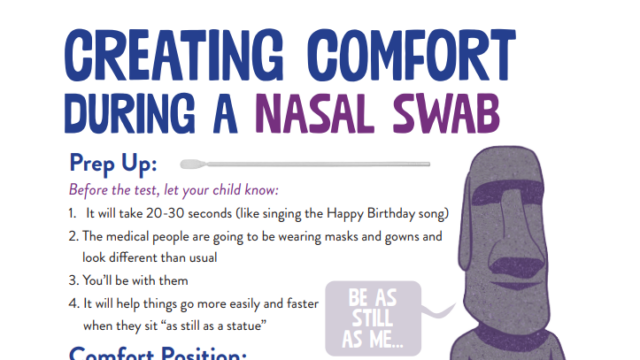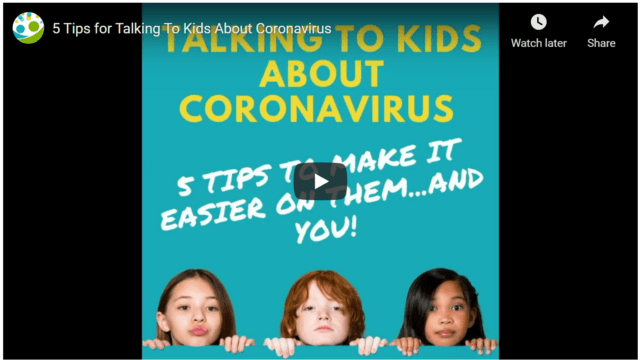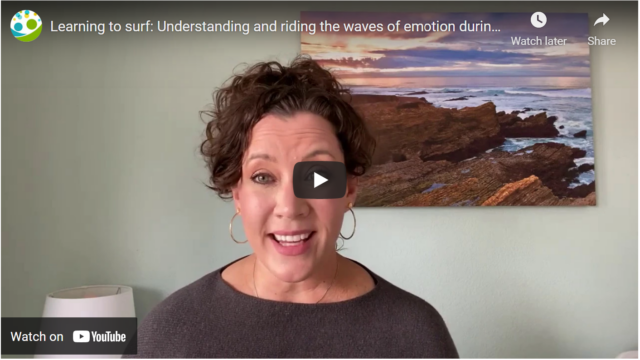Tips for Talking to Your Kids About COVID-19
Talking to your kids about COVID-19 can be tough. You’re not alone and we’re here to help! Here are five tips for navigating this conversation without freaking out.
Jody Thomas, PhD
Kids (3-11) Tweens & Teens (12+) Covid-19 Acute Pain English Pain Management
Share this:
5 Tips to Make it Easier on Them and You
To say this is a stressful and uncertain time is a pretty massive understatement. In the middle of these uncharted waters, we are tasked with having to make sense of it all for not only ourselves, but also for our kids. It’s also a massive understatement to say that it can be overwhelming as a parent to know what we should say. We have to fight our very natural urge to want to protect them from anything scary in the world (and a global pandemic definitely falls into that category). It’s tempting to avoid the conversation all together, but the realities of the massive changes already happening in their world makes that not only a really bad idea, but also impossible. Covid-19 is changing their lives in huge ways, and they need to know you can be a trusted source of information and comfort for them.
At the Meg Foundation, our goal is to empower families with information and tools to bring comfort to kids. In this post, we share five tips (and a few please-dont’s) to help you navigate the choppy waters of conversations with your child about COVID-19 so you can feel more confident about answering their questions and calming any fears they may have.
1. Be Calm
I know it seems like a very tall order right now, but it is hard to overstate how important this one is. So take a deep breath, remember every strategy you’ve ever used to center yourself, and do your best to be calm.
Kids take their cues from us and they know how we feel even when our words might be saying something else. They always seem to know. It’s powerful to remember that while stress is contagious, so is calm.
In this video, I share more about why modeling calm can be the biggest predictor for how your kid will react at the doctor’s office, but it’s true for tough conversations, too…and actually most things in life.
2. Ask Questions
Kids think about things very differently than adults. Case in point? My own 8-year-old told me during our first talk about it that “when you get coronavirus it looks like you are wearing a crown…because corona means crown in Latin. Oh, and old people die.” A good friend’s child thought coronavirus was a like Dementor from Harry Potter because he kept on hearing the phrase “Coronavirus is here.”
When kids have questions, they often have specific things in my mind, while our minds go off in a million directions. Asking questions allows you to figure out exactly what part they are REALLY concerned about, and not have to come up with an for answer everything.
You can use this technique by simply asking, “Good question, why do you ask?” or, “What do you know about coronavirus?” It makes it MUCH easier to fill in the right knowledge gaps and pinpoint their biggest questions and fears.
3. Be Honest
As a medical psychologist, it has been my job for over 20 years to have hard conversations with kids, and here is what I have learned: kids always know more than you think they do. Hiding things is almost always futile…and really can be damaging.
Mr. Rogers succinctly put another big truth: anything that is mentionable can be manageable. Not mentioning things has the opposite effect. Kids need to know they can trust you to talk about the hard stuff. Things get a lot scarier when even the grown ups can’t talk about it.
REMEMBER: It’s possible to be honest without being alarmist!
4. Assure Them They Are Safe
Kids need to hear:
- This doesn’t affect kids very much.
- They are NOT likely to get sick.
- Even if they do, they won’t be very sick.
- We will figure this out together.
- It will be okay.
5. Action is the Enemy of Anxiety
This is one of my favorite sayings for its simplicity and its profound truth. Giving kids (and ourselves) something concrete to do goes a very long way when they are feeling stressed. It’s important for them to understand that there are powerful things they can do to keep themselves and people around them healthy.
Some things they can do include:
- Wash their hands (a lot)
- Cough in their elbows
- Not lick stuff
- Be kind
- Help others not get sick by doing all the above
The last one is particularly useful because it always feels good and powerful to help others!
Let’s finish up with a few things NOT to say. Do your best to avoid these well-intentioned but wildly unhelpful phrases.
“Just Don’t Worry”
Kids are not dumb. They know there is something to worry about…they are trying to figure out how much to worry. Saying this tells them you won’t be honest about that and can make them worry MORE.
“Calm down”
This has never worked in the history of mankind to get someone actually to calm down. We have to help them figure out HOW to calm themselves and how they can feel better and safer.
You’ve Got This!
It’s important to remember that at the end of the day, you’re the true expert on your kid. Use these tips and your natural parental intuition to guide you. We are all in this together, and we are here to help!
Still have questions or comments? We would love to hear from you, and you can always reach us at info@megfoundationforpain.org or fill out the form below!
You May Also Be Interested In
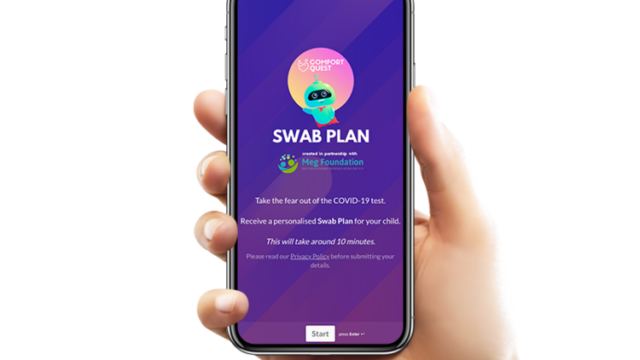
Digital Tool
Nasal Swab Comfort Plan Builder
Our cute robot friend Spud is here to guide your child to create a plan to feel calm and comfortable during a nasal swab!

Article
Treating Needle Fears May Reduce COVID-19 Vaccine Hesitancy Rates by 10%
A new large-scale study shows that a quarter of the UK adult population screens positive for a potential injection phobia.
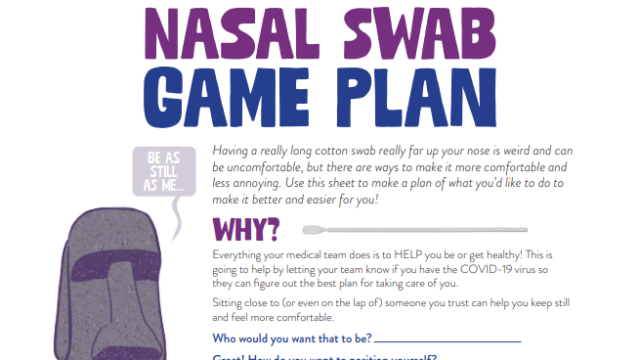
Downloads
Game Plan Worksheet: Creating Comfort During Nasal Swabs
We all do better with a plan! Use this to help kids create a coping plan before that next COVID test.

About the Author
Dr. Jody Thomas is a licensed clinical psychologist, and specialist in pediatric medical illness and trauma. A well-known expert in pediatric pain who teaches internationally on the subject, she is also a founder and the former Clinical Director of the Packard Pediatric Pain Rehabilitation Center at Stanford, and a former Assistant Professor at the Stanford University School of Medicine. Though she now lives in Denver, CO, she still serves as Adjunct Faculty for Stanford, providing supervision and teaching. As a consultant for the Lucile Packard Children’s Hospital at Stanford, she directs projects on the integration and innovation of pain management using tech-based intervention. Her passion for bringing together the power of medical science, technology and design to transform the way we think about kids and pain led her to her current focus but it’s her role as a mom of two that solidified her path in creating the Meg Foundation.
